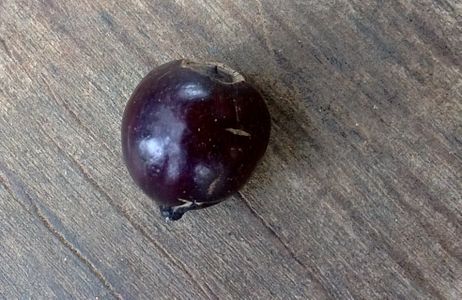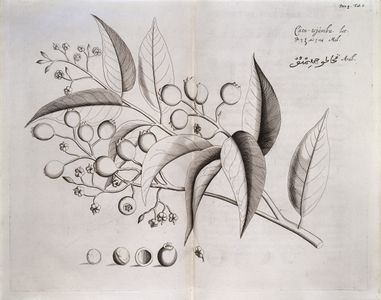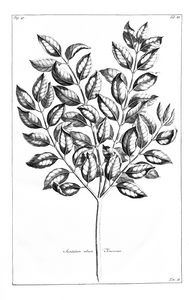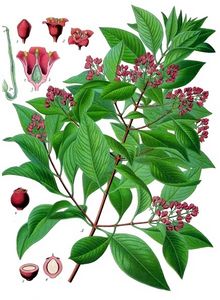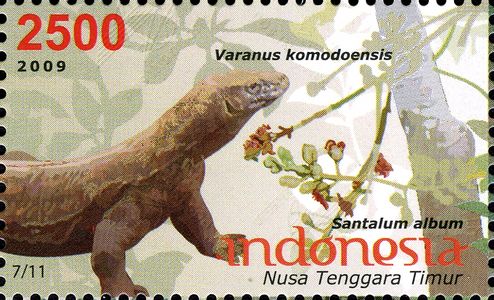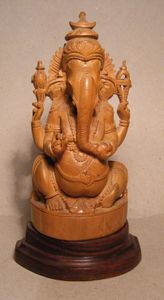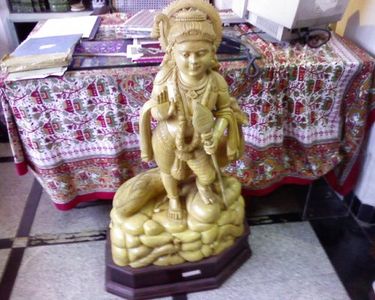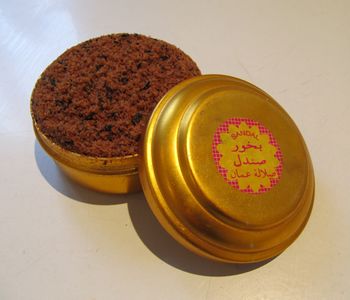Santalum album
Santalum album L.
| Ordre | Santalales |
|---|---|
| Famille | Santalaceae |
| Genre | Santalum |
2n =
Origine : Asie du Sud-Est
sauvage ou cultivé
| Français | santal |
|---|---|
| Anglais | sandalwood |
- plante à parfum (bois de cœur)
- médicinal, cosmétique
- usages rituels
- arôme alimentaire
- bois d'œuvre
- brise-vent
- ornemental
- fruit comestible
Sommaire
Description
- petit arbre à feuilles persistantes, hémi-parasite, inerme, glabre, jusqu'à 20 m de haut, parfois arbustif ou lianescent ; écorce grossière, gris-brun à brun-rouge
- feuilles opposées ou décussées ; limbe ovale, lanceolé-elliptique ou oblong, de 2,5-8 cm × 1,5-4 cm, base obtuse, cunéiforme ou aiguë, bords ondulés, plats ou légèrement recourbés, apex acuminé, vert pâle au-dessus, glauques au-dessous, avec 6-10 paires de nervures secondaires
- inflorescence : panicule ou grappe terminale ou axillaire, de 2-5 cm de long ; pédoncule de 4-20 mm de long ; bractées caduques
- fleurs hermaphrodites, 4(-5)-mères, à tube du périanthe campanulé, de 2 mm de long, à 4 lobes triangulaires-ovales, d'abord jaunâtres, puis brun-rouge
- fruit : drupe ellipsoïde, à 1 graine, de 1 cm de long, avec un col apical ; exocarpe bleu à rouge-noir, mésocarpe succulent ou ferme, endocarpe lisse (PROSEA)
Noms populaires
| français | santal, santal blanc |
| anglais | sandalwood, Indian sandalwood, fragrant sandalwood, white sandalwood |
| allemand | Sandelholzbaum |
| néerlandais | sandelhout |
| italien | sandalo citrino |
| espagnol | sándalo |
| portugais | sândalo |
| grec | σάνταλον - sandalon |
| arabe | صندل - ṣandal |
| persan | صندل - ṣandal |
| chinois | (Flora of China) |
| sanscrit | अनिंदिता - anindita, arishta-phalam, bhadrasara, चन्दनम् - chandanam (Flowers of India) ; chandana, amaditam, taliaparnam (Wealth of India) |
| hindi | चंदन - chandan, संदल - sandal (Flowers of India) ; safed chandan (Wealth of India) |
| ourdou | sandal safaid (Flowers of India) |
| bengali | চংদন্ - chandan, শ্ৱেতচংদন - shwetchandan (Flowers of India) ; peetchandan, srikhanda, sufaid chandan (Wealth of India) |
| marathi | चंदन - chandan, gandhachakoda (Flowers of India) |
| gujerati | sukhad, sukhet (Wealth of India) |
| konkani | sriganda (Wealth of India) |
| telugu | bhadrasri, చందనమ్ - chandanamu (Flowers of India) ; chandanapuchettu, tellagandhapu-chettu (arbre), gandhataruvu (arbre), srigandhamu, gandhapu-chekka (bois) (Wealth of India) |
| tamoul | anukkam, asam, சந்தநம் - chandanam (Flowers of India) ; sandanam, ulocidam, kulavuri (Wealth of India) |
| kannada | ಚಂದನ - chandana, ಗಂಧ - gandha, ಶ್ರೀಗಂಧ - srigandha, bavanna, ಭದ್ರಶ್ರೀ - bhadrasri, ಪಟೇರ - patera (Flowers of India) ; agarugandha, bhandrasri (Wealth of India) |
| malayalam | ചംദനമ് - chandanam, chandana-mutti (Flowers of India) |
| odia | valgaka (Flowers of India) ; chondono, gondassaro (Wealth of India) |
| manipuri | চংদন - chandan (Flowers of India) |
| népalais | श्रीखण्ड - shreekhand (Flowers of India) |
| punjabi | chandan |
| Indonésie | cendana (général), ai nitu (Sumba), hau meni (Timor) (PROSEA) |
| Malaysia | chendana (PROSEA) |
| Thaïlande | chantana (PROSEA) |
| Birmanie | san-ta-ku (PROSEA) |
- Voir l'étymologie de Santalum
- Voir la notice du Trésor de la langue française informatisé
Classification
Santalum album L. (1753)
synonyme :
- Santalum myrtifolium L. (1771)
Cultivars
Histoire
catu-tsjambu vol. 4 pl. 8 Rheede 1683
- Voir Sandel (Traité des simples, Ibn al-Baytar, XIIIe)
- Voir les Coloquios dos simples de Garcia da Orta (1563)
Usages
Native probably in SE Indonesia, however since long times naturalized in India, Sri Lanka, S China, other parts of Indonesia, N Australia. In India, SE Asia, China and Australia cultivated. The species is succesfully introduced into Tanzania, Nigeria, Fiji, Hawaii and to other countries, SE Asia and India being the most important producers. The culture of the semiparasite is difficult, because host plants are needed. About 500 potential host plants are known, among them remarkably many herbaceous species. For sandal cultivation Cassia siamea has been favoured in general. The hardwood is white or lemon-coloured, rarely reddish and very fragrant (yellow sandalwood). It is used variously for cabinetry and is highly esteemed in the Orient. The distillation of the hardwood yields the East Indian Sandalwood oil (Oleum santali). It is officinal but the main use is in the production of Oriental perfumes. It is also utilised in the production of cosmetics like soaps, powder, creams. Indian literature mentioned Santalum album earliest circa 500 BC (Nirukta) and 400-300 BC (Anjuttara, Vinya Pitaka), but probably sandalwood was utilized long before in religious ceremonies. It became an essential part of Brahmin, Buddhist and other religious rituals. Incense was also closely connected with Hindi erotic arts. Sandalwood and its products were brought eastwards to China and incorporated into almost every parts of daily life. Arabian and Persian merchants brought sandalwood westwards. - In Europe it was first mentioned in the first cent. AD, and then AD 545 by Cosmos Indicopleustes of Alexandria. Domestication and first production of Sandelwood Oil took place obviously in India, using stills imported by Arabian merchants. Breeding progress achieves strains with a better yield of oil and resistance against spike disease, which heavily effects the cultivation of sandalwood tree and the sandalwood industry.
L'aubier est blanc à blanc-jaunâtre, n'a pas d'odeur et semble ne pas être utilisé. Le bois de cœur est odorant, brun-jaunâtre à l'état frais, devenant brun foncé à l'air, puis brun-rougeâtre. Il est probable que la distinction souvent faite entre "santal blanc" et "santal jaune" (ou "citrin") tienne à ces différences de couleurs du bois de cœur.
Le bois de santal est très utilisé dans les bûchers funéraires en Inde. La pâte de santal est un ingrédient du tilaka, la tache rouge que portent au front de nombreux Hindous.
Dans son roman Le supplice du santal, Mo Yan détaille la préparation (et l'usage) d'un pieu de santal pour empaler un supplicié. Le pieu est préalablement bouillie dans de l'huile de sésame (Sesamum indicum) ou de tung (Vernicia fordii) pour qu'il glisse mieux...
Références
- Mo Yan, 2006. Le supplice du santal. Paris, Seuil. (Collection Points). 722 p. (Tanxiang xing, 2001).
- Roubo, André-Jacob, 1774. L’Art du Menuisier. L’art du menuisier-ébéniste — 3e section de la 3e partie. pp. 768-781. Voir sur Pl@ntUse : Citron et Santal


